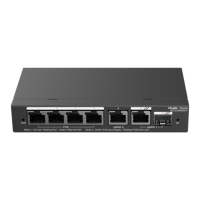CLI Reference SEM Configuration Commands
Configuring an event for the policy
Configuring an action for the policy
Configuring the description of the policy
Configuring the triggering parameter of the policy
Submitting the policy configuration
Rolling back the policy configuration
Viewing the current policy configuration
Each event must have a unique name specified by parameter tag. SEM
automatically arranges events by tag alphabetically. Each action must be
assigned a unique label. SEM automatically arranges actions by label
alphabetically. When a policy is activated, actions are performed by label
alphabetically.
In SEM configuration mode, you can use environment variables in policy
actions. There are two kinds of variables:
Global variable
Local variable
A local variable can be defined by a system event detector when an event
occurs, or by an action while a policy is running. For the system variables
that are generated by each kind of event, refer to use guide.
The policy configuration does not take effect until the
commit command is used in SEM configuration mode to
submit it.
A policy is checked for validity when it is submitted. If the
policy configuration does not pass the validity check,
policy registration and the submission fail.
A policy without any event configured cannot pass the
validity check.
A policy without action can pass the validity check, but
does nothing after being triggered. Therefore, an alarm is
sent when such a policy is submitted.
To give up your policy modification, you can use the
rollback command to roll back.
The SEM policy does not take effect when starting up the
device, and it takes effect only when the configuration
configured on the device’s Cosole is available. For details,
refer to the smart manager policy bootup-delay.
Each policy corresponds to a class. The default class is
default. Multiple policies can belong to one class. A
class is used to allocate thread resources to and specify
the running priority for the policies in it.

